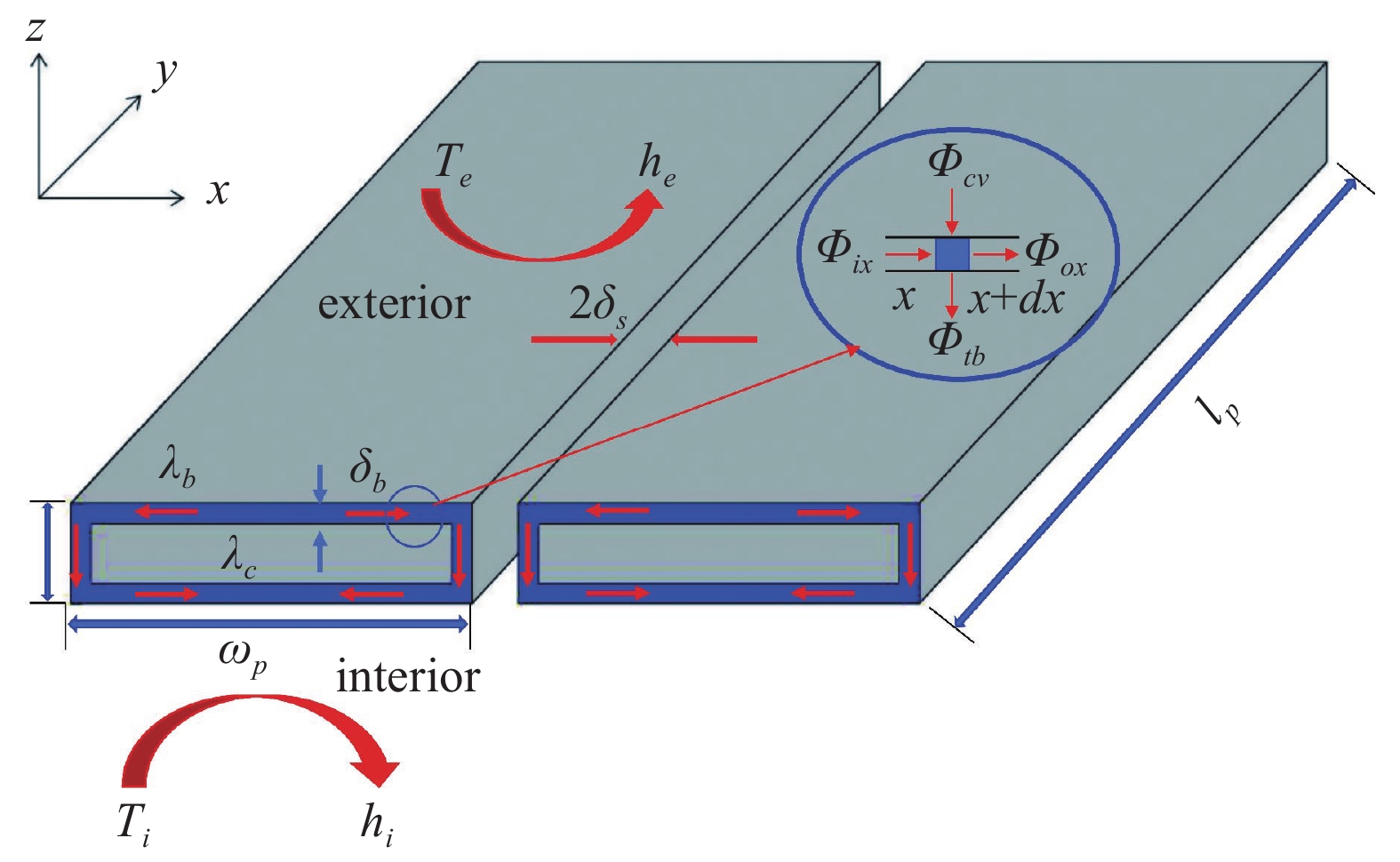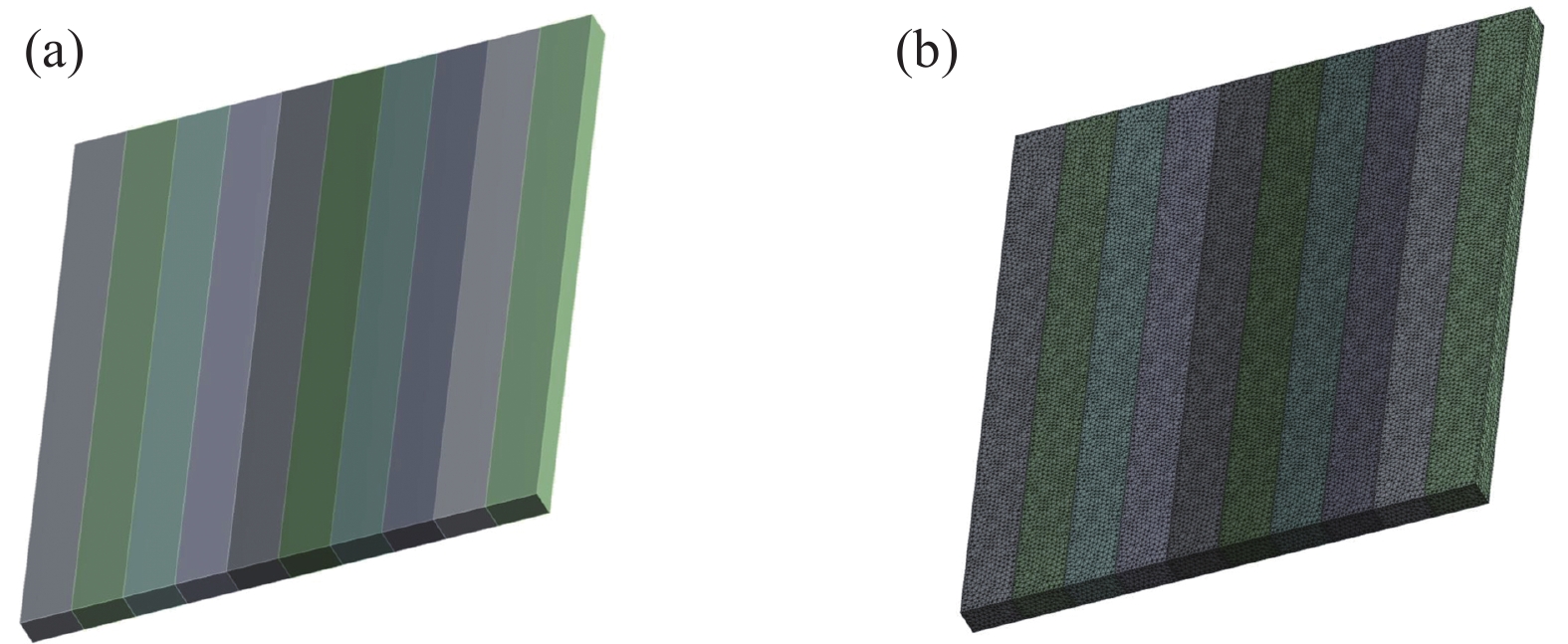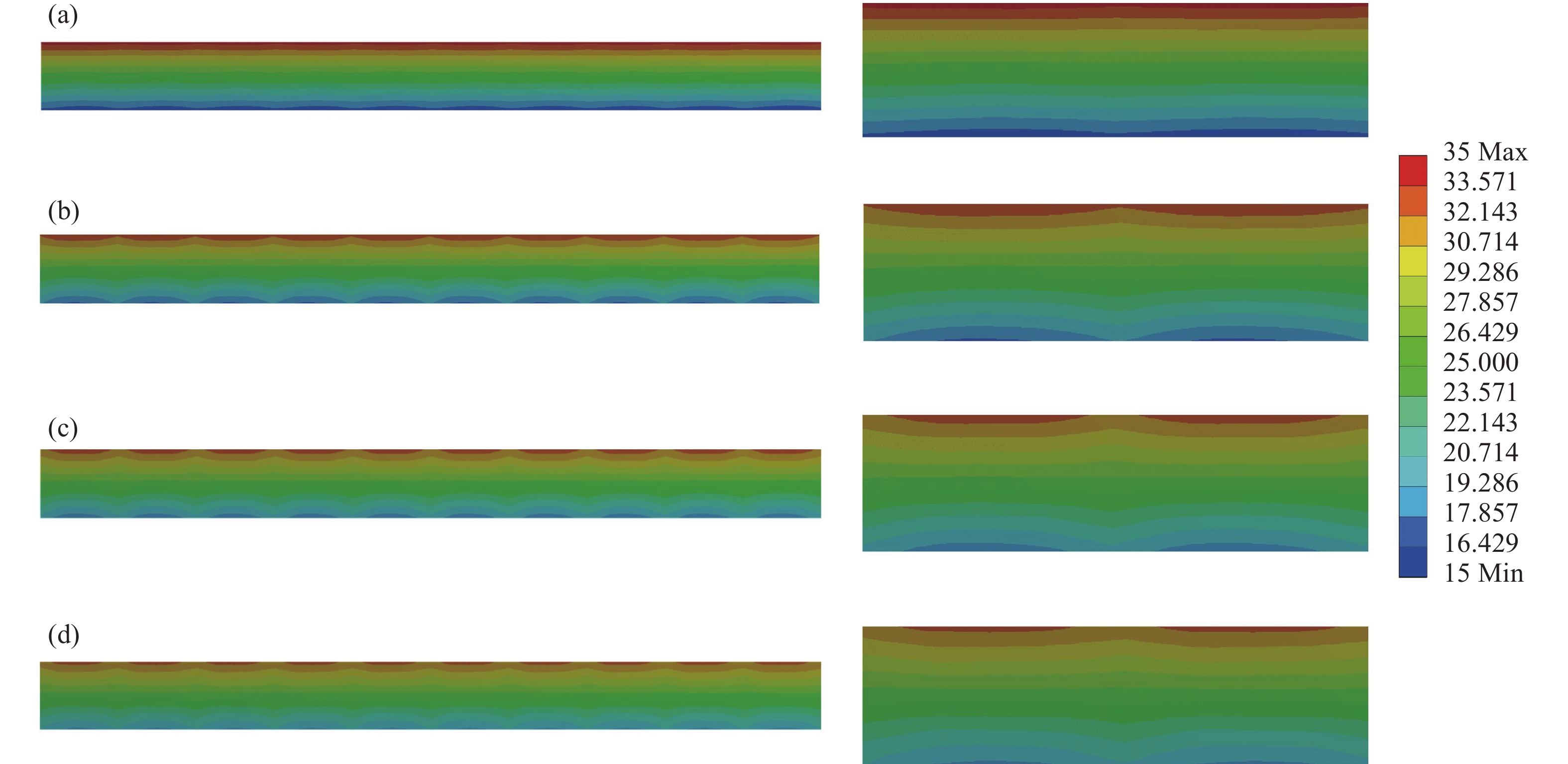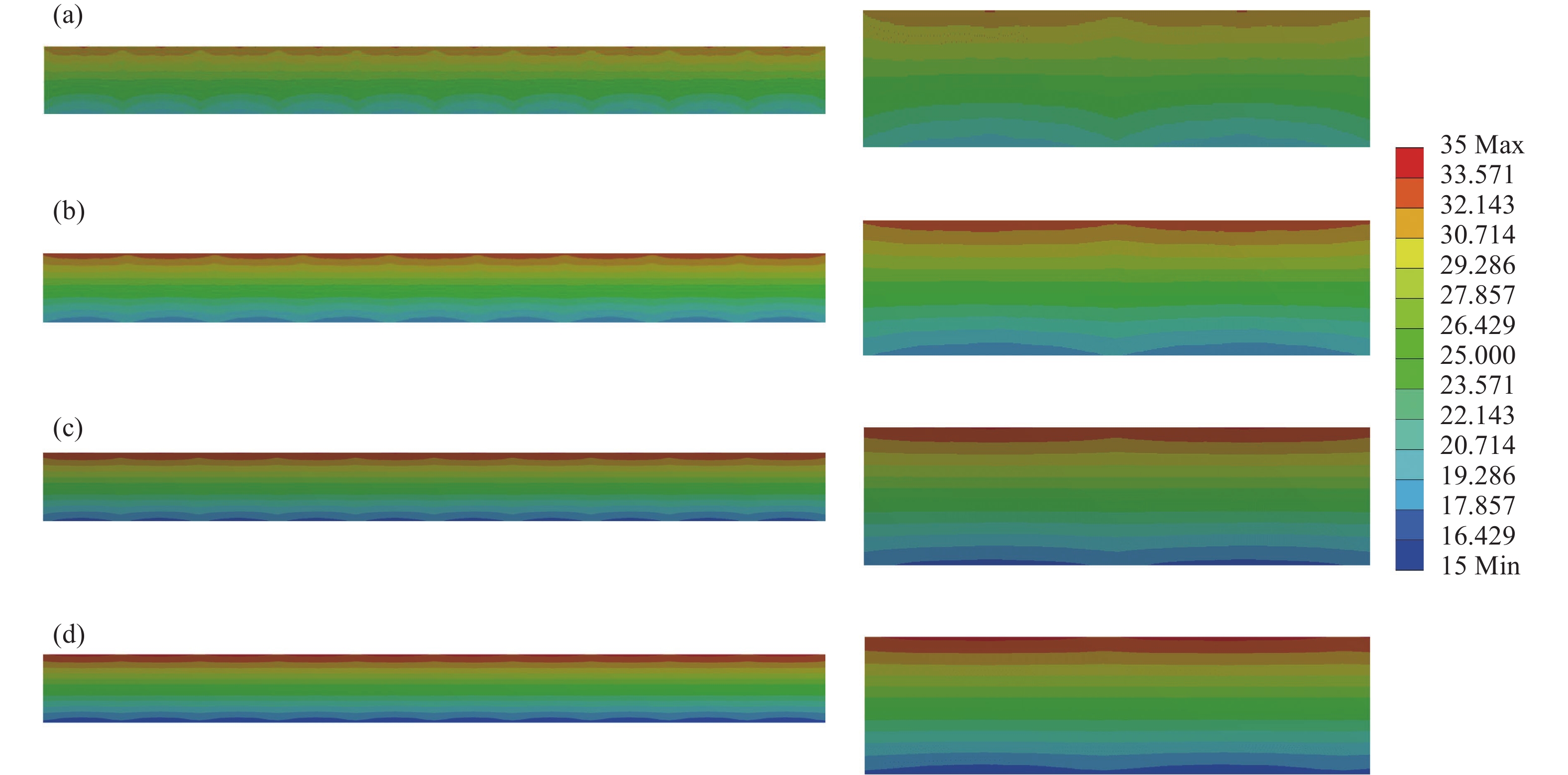-
保温材料经过一百多年的发展,研究开发新型环保、节能、高效的保温材料已成为当务之急[1-6]。VIP(真空绝热板)是目前最有希望提供最高隔热性能的解决方案。作为一种高效的保温材料,它将在未来保温的各个领域,特别是在建筑应用中发挥不可替代的作用[7]。在正常压力和温度下,面板中心具有的导热系数低至1.5 mW/(m·K)−4 mW/(m·K)[8-10]。但是在应用过程中也受到限制,主要表现为外部阻隔膜与内部芯材导热系数差异过大导致热桥效应[11]。
国内学者阚安康等[12]对计算模型进行优化并提出降低“边缘效应”对策。温永刚等[13]用Matlab对不同VIP芯材导热性能对“边缘效应”的影响进行了数值模拟。如果要想更加准确的研究热桥,就需要系统的数值模拟热传递过程,其中包括边缘设计(单层或者多层边缘设计)的种类、VIP厚度、阻隔膜类型、阻隔膜厚度[14-15]。
国外Mandilaras[16]评估了绝缘材料的导热系数受到环境工作条件及随着材料年龄变化的影响,特别在冷湿环境中,绝缘材料传热对导热系数有很大影响。Umberto[17]分析温度对于真空绝热板(VIP)导热系数的影响,对于建筑构件耐久的分析采用数值模拟的方法,从中突出不同的温度和热桥效应的关系,热桥效应越大对于VIP老化的影响越明显。其次,为了评估VIP产品的有效导热系数,从VIP厚度、VIP导热系数、芯材导热系数等因素对线性导热系数影响进行了研究。Tenpierik[18]研究了VIP特性与阻隔膜特性对热桥效应的影响。Fantucci[19]通过建立热桥模型,结果表明,VIP的尺寸较大,热桥越小,隔热性能越好。
综上所述,评估真空绝热板的热性能关键在于应用期间由外部因素导致的热损失。除此之外,由热桥效应引起的热损失也需引起重视,通过对国内外不同学者的总结所得到的结论都说明了考虑热桥效应是正确评价VIP绝热性能的关键。
-
通常情况下,热桥即热传输。如图1所示,在热量由高温向低温传递的过程中,会有部分热量经过边缘的传递,热流也会由高温向低温源源不断的传递,形成热桥。
保温材料的导热系数随温度呈非线性增长。根据傅里叶定律,等效导热系数
$ {\lambda }_{e} $ 可由大温差试验获得。如图2所示,热板温度为$ {T}_{H} $ ,冷板温度为$ {T}_{N} $ ,板厚为$ \delta $ ,热通量为$ q $ ,可按式(1)进行计算获得。面板中心的有效导热系数是评估VIP的整体性能的关键,标准热绝缘体的横截面是均匀的,面板中心的值等于总值。VIP的中心导热系数由三部分组成:通过芯材的固体导热系数、残余气体导热系数和辐射导热系数。可以用式(2)评估VIP的面板中心导热系数:
对于VIP在实际应用中而言,VIP安装在各种维护结构构件中,其产生的边缘线性传热和角处的接触传热是影响VIP性能的主要因素。对此传热数值分别用
$ {\psi }_{l} $ 和$ {\chi }_{p} $ 表示,如果$ \psi $ 值在已知情况下,VIP的面积为$ S $ 、周长为$ l $ 以及接触角的个数为$ n $ 时,VIP的整体传热系数$ {U}_{eff} $ 可用式(3)进行描述:式中:
$ {U}_{u} $ 是面板的传热系数,$ {l}_{i} $ 是接触侧面的周长,$ {n}_{j} $ 是接触角的个数,$ S $ 为VIP一侧的面积,$ {\psi }_{l} $ 是接触侧面边缘线性传热率,$ {\chi }_{p} $ 是接触角的传热系数,$ {\psi }_{l} $ 和$ {\chi }_{p} $ 由不同的边缘条件所确定。在此研究的模型中,由于点热桥效应远远小于边缘的线热桥效应,因此本研究忽略了点热桥效应的影响,其方程化简为:常规隔热材料的特征在于其面板中心的传热系数
${U}_{{\rm{cop}}}$ (W/m2·K),其定义为:式中:
$ {\delta }_{p} $ 表示VIP板的厚度,${\lambda }_{{\rm{cop}}}$ 表示VIP板中心的导热系数,$ {h}_{i} $ 和$ {h}_{e} $ 分别为VIP板冷热表面的换热系数。 -
本实验研究的单向切割真空绝热板是由10个真空单元组成的,每个真空单元的尺寸为20 mm×200 mm,从而构成200 mm×200 mm的真空绝热板。此真空板弥补了传统真空绝热板不可切割的缺点,优点在于可以横向切割,尺寸灵活,不会对真空绝热板的整体性能造成影响,导热系数的变化值保持在最优状态。制备过程如图3所示。
通过考虑几个主要影响热桥的参数,选取部分构件建立了如图4所示的三维数值模型:
事实上,在稳定状态下由能量守恒定律可以定义为:
为了在不损失计算精度的情况下进行简化,假设阻隔膜结构均匀且平整,阻隔膜厚度和导热系数是不变的,等式两边除以
$ {\rm{d}}x·{\mathrm{\delta }}_{b}·{\mathrm{\delta }}_{p} $ ,最后得到:同理,在热量的y方向可以表达为:
以上等式合并并以线性导热系数
$ {\psi }_{l} $ 为边界条件,得出:线性导热系数
$ {\psi }_{l} $ 由式(6)到(10)得到,主要由VIP厚度,阻隔膜厚度,芯材导热系数,阻隔膜导热系数以及VIP表面对流换热系数等因素决定。按照上述计算方法,可以得出在组装情况下,VIP板材的边缘线性导热系数:
由此可得VIP边界线性传热系数还与连接处填充介质的厚度
$ {\delta }_{s} $ 与导热系数$ {\lambda }_{s} $ 有关。 -
实际应用过程中,单向切割真空绝热板由条状独立的真空单元引起的线性热桥效应分析尤为重要,并且对有效导热系数的损失产生了重大影响。为了使模拟分析更快、更可行,在不损失精度的情况下,需要进行一些简化。因此,引入了由10个面板尺寸为20 mm×200 mm,厚度为10 mm的结构进行分析。几何模型是通过Ansys软件进行,Ansys是一种用于模拟工作传热的模拟技术。由于模型形状规则,结构简单,因此选择四面体网格来构建网格,如图5所示。
为方便数值分析与模拟计算,需要设置一定的边界条件。根据不同材料的物性参数,选择适当的边界条件十分重要。本论文的边界条件参考了学者阚安康的研究[12],
$ {t}_{e} $ =35℃,$ {t}_{i} $ =15℃,相应的隔气结构冷热表面换热系数$ {h}_{i} $ 和$ {h}_{e} $ 如表1所示[11]。隔气结构的种类和导热系数如表2所示,VIPs的芯材厚度通常在5~20 mm之间,气凝胶芯材的导热系数为0.019 W/(m·K),阻隔膜导热系数取0.42 W/(m·K),代入上式分析计算。通过控制变量法,研究了不同参数对于单向切割真空绝热板热桥效应的影响。把阻隔膜厚度和单向切割真空绝热板总厚度设置为自变量,剩余参数恒定。通过对图5所示的模型进行传热数值模拟,监测了试件冷热表面的温度分布。采用ANSYS19.2软件进行数值模拟。研究了不同阻隔膜厚度、单向切割真空绝热板总厚度的温度分布,从而判断热桥效应的大小。
图6描述了由10个宽度为20 mm独立的条状真空单元、总厚度为10 mm厚度组成的单向切割真空绝热板,阻隔膜厚度的变化对单向切割真空绝热板热桥效应的影响。按照热桥效应强度的图示法评判法则,从上至下等温线的弯曲程度显著增强,特别是由图中蓝色区域和绿色区域的过渡线可以发现,过渡线逐渐向拱形靠拢。另外,单向切割真空绝热板两侧表面上,蓝色区域明显缩小至板厚中心位置,研究表明得知阻隔膜厚度对单向切割真空绝热板热桥效应有显著影响。
图7描述了由10个宽度为20 mm独立的条状真空单元、0.2 mm厚度阻隔膜保持不变的情况下,单向切割真空绝热板总厚度的变化对单向切割真空绝热板热桥效应的影响。随着单向切割真空绝热板厚度的增加,从上到下热等温线的弯曲程度逐渐减小,贴合度逐渐增高,法平面的温度分布虽然有不均匀化趋势,但是逐渐平缓,热桥效应减弱。
当单一变量采用0.1−0.4 mm厚的阻隔膜,其他基本条件保持不变用以上式子计算出线性导热系数如表3所示。当单一变量为单向切割VIP的总厚度(5~20 mm),阻隔膜厚度为0.2 mm。另一变量导热系数递增,厚度均为10 mm,其他基本条件保持不变用以上式子计算出线性导热系数如表4所示。
通过表3和表4的计算结果可知,当单一变量设为阻隔膜的厚度时,随着阻隔膜的厚度增加,边缘热桥效应随之增大。当单一变量设为单向切割VIP的总厚度时,随着单向切割VIP厚度的增加,边缘热桥效应随之减小。相比之下,阻隔膜的厚度对热桥的影响远大于单向切割VIP总厚度的影响,其热流的损失对于阻隔膜的厚度增加呈线性增长。芯材的导热系数对单向切割VIP线性热桥效应会有一定程度的影响,当自变量为芯材的导热系数,当导热系数逐渐增大时,其线性导热系数也会减小,从而热桥效应也会减弱。经计算,以VIP的总厚度
$ {\delta }_{p} $ =10 mm为例,VIP中心导热系数$ {\lambda }_{c} $ =0.019 W/(m·K)比$ {\lambda }_{c} $ =0.023 W/(m·K)时的热流损失接近4.6%。 -
本实验采用不含金属箔作为真空绝热板的阻隔膜,其材质为对称结构PE/PA/EVOH多层共挤膜。与其他材质的阻隔膜相比,具有强度高、耐穿刺、阻隔性能强、可耐受零下30℃低温冷冻,具有高阻氧阻湿性能。选择气凝胶毡为真空绝热板芯材,气凝胶毡隔热效果突出、保温后的热损失较少、空间利用率高,抗拉和抗压强度高。提高真空绝热板使用寿命。材料属性列于表5。
本实验在单元吸塑的真空阻隔膜内填充芯材进行抽真空,然后再把两个抽完真空的单元吸塑的真空板拼接在一块,每个独立的真空单元尺寸为20 mm×200 mm,从而构成尺寸为200 mm×200 mm的真空绝热板。为了保证拼接时不留气缝,需特别注意裁剪芯材时的标准尺寸,以免造成误差,同时记录导热系数数据。本实验所用的实验装置如表6所示。
按照实验方案的规划,实验数据被分成4组,每组含3个数据。每项试验大约需要120 min左右。在试验中热板温度定为35℃,冷板温度定为15℃,用12组数据测得其中心区域导热系数如表7。
本实验测得的单向切割真空绝热板导热系数可能会有误差,主要是由以下因素导致:
(1)单向切割真空绝热板制备完成后,由于热封宽度导致多余的封边,导热系数测量时,会对实验结果精度造成影响。尽管已尽量剪掉了多余的封边,折叠区域会使其单向切割真空绝热板厚度变大,导致其实验存在误差。
(2)有限元仿真模拟是在理想状态下进行模拟,但试验过程不如理论与仿真情况那样平稳,所以数据存在误差。
-
单向切割真空绝热板相对于传统保温材料而言,既能阻止热传递又能提高能源的利用率。然而,在实际使用中仍然无法避免热桥效应。本研究基于传热模型,同时使用线性热透射率评价热桥的标准。根据研究结果,得出以下结论:
(1)本文对单向切割真空绝热板中的热桥现象进行了软件模拟和计算分析,研究对象为同一类型的隔板,但阻隔膜厚度不同。结果表明,真空绝热板阻隔膜厚度对各种热桥引起的线性透射率的影响可以通过数值计算和模拟来检测。随着阻隔膜厚度的增加,热桥效应也会变大。
(2)较高的单向切割真空绝热板厚度可以获得较低的线性透射率。当厚度在5~20 mm之间变化时,线性热透射率指数从0.935×
$ {10}^{-3} $ 降低到0.358×$ {10}^{-3} $ W/(m·k)。因此,高厚度是首选的建筑围护结构,以提高能源利用效率。(3)与相同单向切割真空绝热板的理想绝热相比,本文的分析表明,考虑热桥效应时有效导热系数
$ {\lambda }_{{\rm{eff}}} $ 可提高42%,即通过减小热桥效应热损失。该研究为单向切割真空绝热板的实际应用提供了实验方法。
单向切割真空绝热板热桥效应研究
Thermal Bridge Effect of Unidirectional Cutting Vacuum Insulation Panels
-
摘要: 为了提高单向切割真空绝热板应用的广泛性,重点在于研究其绝热性能,提出以热桥效应为对象进行研究。文章采用线性传热率这一概念作为评价热桥效应的基准量。运用理论分析的方法、建立数学模型,进行了单向切割真空绝热板热桥效应分析。根据稳态传热边界条件,提出了热流传递模型,对阻隔膜的厚度和VIP的总厚度两个参数进行分析和计算。实验结果表明,芯材的厚度与导热、阻隔膜厚度与导热、VIP的大小与拼接之间的缝隙都会对热桥效应造成影响。其中芯材导热和厚度得到提高,阻隔膜导热和厚度降低,拼接缝内填充介质导热和厚度降低,VIP尺寸增加,热桥效应呈减弱趋势。文章通过对比有无热桥效应的单向切割真空绝热板,其有效导热系数可提升42%,进而实现对单向切割真空绝热板的高效利用率,增加其绝热性能。Abstract: In order to improve the universality of the application of unidirectional cutting vacuum insulation panels, the emphasis is on the research of its thermal insulation performance, and the thermal bridge effect is proposed to be studied. In this paper, the concept of linear heat transfer rate is used as the benchmark to evaluate the thermal bridge effect. By using the method of theoretical analysis and establishing a mathematical model, the thermal bridge effect of the unidirectional cutting vacuum insulation panel is analyzed. According to the steady heat transfer boundary conditions, a heat flow transfer model is proposed to analyze and calculate the thickness of the barrier film and the total thickness of VIP. The experimental results show that the thickness of the core material and heat conduction, the thickness of the barrier and heat conduction, the size of the VIP and the gap between the splices all affect the thermal bridge effect. The heat conduction and thickness of the core material are improved, the heat conduction and thickness of the barrier are reduced, the heat conduction and thickness of the medium filled in the splice joint are reduced, the VIP size is increased, and the thermal bridge effect is weakened. In this paper, the effective thermal conductivity of the unidirectional cutting vacuum insulation plate with or without thermal bridge effect can be increased by 42%, thereby realizing the efficient utilization of the unidirectional cutting vacuum insulation panel and increasing its thermal insulation performance.
-

-
图 3 单向切割真空绝热板的制备过程。(a)阻隔膜吸塑成型,(b)填充芯材,(c)芯材压实,(d)敷平膜热压抽真空,(e)拼接单向切割真空绝热板侧面图,(f)单向切割真空绝热板
Figure 3. Preparation process of unidirectional cutting vacuum insulation panel. (a) Diaphragm suction molding, (b) filling core material, (c) core material compaction, (d) flat film hot pressing vacuum pumping, (e) splicing unidirectional cutting vacuum insulation panel side view, (f) unidirectional cutting vacuum insulation panel
类型 温度/K 对流换热系数
W/(m²·K)冷面 288 7.8 热面 308 25 表 2 VIP的属性
Table 2. VIP attributes
类型 导热系数 厚度 阻隔膜 PE 0.42 24 μm EVOH - 2 μm PA 0.25 9 μm 芯材 气凝胶毡 0.019 5-20 mm 表 3 不同阻隔膜厚度线性导热系数计算结果
Table 3. Calculation results of linear thermal conductivity for different diaphragm thickness
序号 $ {\lambda }_{c}/ $ W/
(m·K)$ {\lambda }_{b}/ $ W/
(m·K)${\delta }_{b}/{\rm{mm}}$ ${\delta }_{p}/{\rm{mm}}$ $ {\psi }_{l}/ $ W/
(m·k)1 0.019 0.42 0.1 20 0.180× $ {10}^{-3} $ 2 0.019 0.42 0.2 20 0.358× $ {10}^{-3} $ 3 0.019 0.42 0.3 20 0.534× $ {10}^{-3} $ 4 0.019 0.42 0.4 20 0.707× $ {10}^{-3} $ 表 4 不同单向切割VIP总厚度线性导热系数计算结果
Table 4. Calculation results of linear thermal conductivity for VIP total thickness of different unidirectional cutting
序号 $ {\lambda }_{c}/ $ W/
(m·K)$ {\lambda }_{b}/ $ W/
(m·K)${\delta }_{b}/{\rm{mm}}$ ${\delta }_{p}/{\rm{mm}}$ $ {\psi }_{l}/ $ W/
(m·k)1 0.019 0.42 0.2 5 0.935× $ {10}^{-3} $ 2 0.019 0.42 0.2 10 0.616× $ {10}^{-3} $ 3 0.019 0.42 0.2 15 0.453× $ {10}^{-3} $ 4 0.019 0.42 0.2 20 0.358× $ {10}^{-3} $ 5 0.020 0.42 0.2 10 0.608× $ {10}^{-3} $ 6 0.021 0.42 0.2 10 0.601× $ {10}^{-3} $ 7 0.022 0.42 0.2 10 0.594× $ {10}^{-3} $ 8 0.023 0.42 0.2 10 0.588× $ {10}^{-3} $ 表 5 材料物性参数
Table 5. Material physical parameters
材料 密度(kg/m3) 导热系数(W/(m·K)) 真空绝热板 220 0.005 空气 1.29 0.023 表 6 实验装置
Table 6. Experimental apparatus
序号 实验装置名称 1 FR-600连续封口机 2 纳米材料真空隔热成型系统 3 TA导热系数测量仪 4 切割刀 5 电热恒温鼓风干燥箱 表 7 导热系数测量数据
Table 7. Thermal conductivity measurement data
序号 T热板/℃ T冷板/℃ 厚度/mm 导热系数/
(W/(m·K))1 35.05 15.05 10.2 0.0055 2 35.05 15.03 12.5 0.0059 3 35.02 15.05 11.3 0.0057 4 35.01 15.02 13.5 0.0061 5 35.03 15.01 10.2 0.0054 6 35.02 15.02 11.7 0.0056 7 35.02 15.01 11.5 0.0055 8 35.02 15.03 12.8 0.006 9 35.03 15.02 12.6 0.0061 10 35.01 15.02 13.5 0.0068 11 35.02 15.04 14.6 0.0065 12 35.01 15.03 15.8 0.0071 -
[1] Zhu W P,Duan Z C,Chen Z F,et al. Recent research progress of vacuum insulation panel[J]. Aerospace Materials & Technology,2013,43(03):36−41 (朱万平,段正才,陈照峰,等. 真空绝热板的研究进展[J]. 宇航材料工艺,2013,43(03):36−41(in chinese) doi: 10.3969/j.issn.1007-2330.2013.03.006 Zhu W P, Duan Z C, Chen Z F, et al. Recent Research Progress of Vacuum Insulation Panel[J]. Aerospace Materials & Technology, 2013, 43(03): 36-41 (in chinese) doi: 10.3969/j.issn.1007-2330.2013.03.006 [2] Simen E K,Bjørn P J. Vacuum insulation panel products: A state-of-the-art review and future research pathways[J]. Applied Energy,2014,116(1):355−375 [3] Chen Z F,Li C D,Chen Q,et al. Research progress of vacuum insulation panel core materials[J]. Science & Technology Review,2014,32(09):59−62 (陈照峰,李承东,陈清,等. 真空绝热板芯材研究进展[J]. 科技导报,2014,32(09):59−62(in chinese) doi: 10.3981/j.issn.1000-7857.2014.09.008 Chen Z F, Li C D, Chen Q, et al. Research Progress of Vacuum Insulation Panel Core Materials[J]. Science & Technology Review, 2014, 32(09): 59-62 (in chinese) doi: 10.3981/j.issn.1000-7857.2014.09.008 [4] Kan A K,Kang L Y,Cao D,et al. Impact of barrier laminate on effective thermal conductivity and service-life of vacuum insulation panel[J]. Chinese Journal of Vacuum Science and Technology,2015,35(05):538−543 (阚安康,康丽云,曹丹,等. 隔气结构膜对真空绝热板热工性能及使用寿命的影响[J]. 真空科学与技术学报,2015,35(05):538−543(in chinese) Kan A K, Kang L Y, Cao D, et al. Impact of Barrier Laminate on Effective Thermal Conductivity and Service-Life of Vacuum Insulation Panel[J]. Chinese Journal of Vacuum Science and Technology, 2015, 35(05): 538-543 (in chinese) [5] Tu C X,Zhao W G,Dai D S,et al. Core materials of vacuum insulation panels: retrospect and prospect[J]. Materials Reports,2017,31(S2):428−432 (涂春炘,赵伟刚,戴达松,等. 真空绝热板芯材回顾和发展[J]. 材料导报,2017,31(S2):428−432(in chinese) Tu C X, Zhao W G, Dai D S, et al. Core Materials of Vacuum Insulation Panels: Retrospect and Prospect[J]. Materials Reports, 2017, 31(S2): 428-432 (in chinese) [6] Jiří Z,Jitka P,Tadej S,et al. Development of vacuum insulating panels (VIP) with non-traditional core materials[J]. Energy & Buildings,2019,199(09):12−19 [7] Zhang N,Yang C G,Gao X,et al. Analysis of influencing factors on internal vacuum of vacuum insulated panel and improving measures[J]. Vacuum,2010(1):19−22 (张宁,杨春光,高霞,等. 真空绝热板内部真空度的影响因素分析及改善措施[J]. 真空,2010(1):19−22(in chinese) doi: 10.13385/j.cnki.vacuum.2010.01.008 Zhang N, Yang C G, Gao X, et al. Analysis of influencing factors on internal vacuum of vacuum insulated panel and improving measures[J]. Vacuum, 2010(1): 19-22 (in chinese) doi: 10.13385/j.cnki.vacuum.2010.01.008 [8] Kuninari A,Daigorou K,Shin-ichi M. Optimization about multilayer laminated film and getter device materials of vacuum insulation panel for using at high temperature[J]. Journal of Materials Processing Tech,2008,209(1):271−282 [9] Mathias B,Thierry D,Dominique B,et al. Heat transfer modeling in vacuum insulation panels containing nanoporous silicas—a review[J]. Energy Build,2012,54(11):320−336 [10] Chen Z,Chen Z F,Yang Z G,et al. Preparation and characterization of vacuum insulation panels with super-stratified glass fiber core material[J]. Energy,2015,93(12):945−954 [11] Mao S,Kan A K,Wang N. Numerical analysis and experimental investigation on thermal bridge effect of vacuum insulation panel[J]. Applied Thermal Engineering,2020,169(C):235−245 [12] Zhang T T,Kan A K,Cao D,et al. Modeling and simulation of thermal bridge effect of vacuum insulation panels[J]. Chinese Journal of Vacuum Science and Technology,2015,35(02):142−149 (张婷婷,阚安康,曹丹,等. 真空绝热板热桥效应传热模型分析与优化[J]. 真空科学与技术学报,2015,35(02):142−149(in chinese) doi: 10.13922/j.cnki.cjovst.2015.02.04 Zhang T T, Kan A K, Cao D, et al. Modeling and Simulation of Thermal Bridge Effect of Vacuum Insulation Panels[J]. Chinese Journal of Vacuum Science and Technology, 2015, 35(02): 142-149 (in chinese) doi: 10.13922/j.cnki.cjovst.2015.02.04 [13] Wen Y G,Wang X R,Dong L,et al. Analysis on extended model of thermal bridge effect of vacuum insulation panel[J]. Cryogenics & Superconductivity,2011,39(1):59−62, 75 (温永刚,王先荣,董亮,等. 真空绝热板(VIP)热桥效应的扩展模型分析[J]. 低温与超导,2011,39(1):59−62, 75(in chinese) Wen Y G, Wang X R, Dong L, et al. Analysis on extended model of thermal bridge effect of vacuum insulation panel[J]Cryogenics & Superconductivity, 2011, 39(01): 59-62, 75 [14] K. Ghazi W, T. Stahl, S. Brunner. Effective thermal conductivity of a staggered double layer of vacuum insulation panels[J]. Energy & Buildings,2011,43(6):1241−1246 [15] Gonçalves M,Simoes N,Serra C,et al. Study of the edge thermal bridging effect in vacuum insulation panels: Steady and unsteady-state approaches using numerical and experimental methods[J]. Energy & Buildings,2022,258(03):111821.1−111821.16 [16] I. Mandilaras, I. Atsonios, G. Zannis, et al. Thermal performance of a building envelope incorporating ETICS with vacuum insulation panels and EPS[J]. Energy & Buildings,2014,85(12):654−665 [17] Umberto Berardi. The impact of aging and environmental conditions on the effective thermal conductivity of several foam materials[J]. Energy,2019,182(09):777−794 [18] Tenpierik M. Analytical models for calculating thermal bridge effects caused by thin high barrier envelopes around vacuum insulation panels[J]. Journal of Building Physics,2007,30(3):254−263 [19] Fantucci S,Lorenzati A,Capozzoli A,et al. Analysis of the temperature dependence of the thermal conductivity in vacuum insulation panels[J]. Energy & Buildings,2018,183(01):64−74 -


 首页
首页 登录
登录 注册
注册




 下载:
下载:





